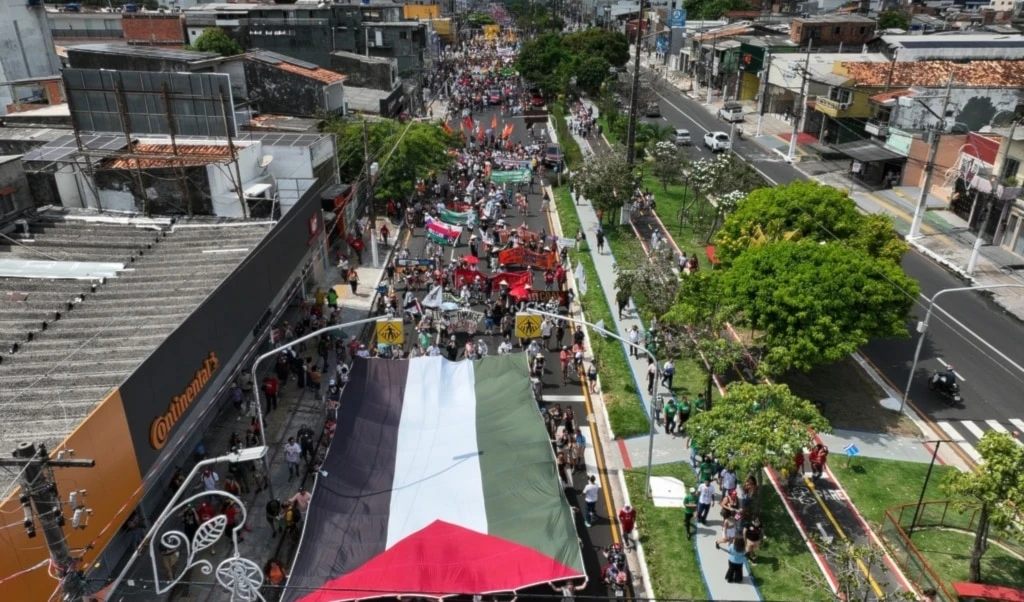Thousands hit streets of Belem to call for action at COP30
Tens of thousands of activists, led by Indigenous communities, marched in Belem during COP30, demanding urgent climate action, protection of biodiversity, and climate finance for Amazonian communities.
-

Activists participate in a climate protest during the COP30 Climate Summit, on November 15, 2025, in Belem, Brazil. (AP)
The streets of Belem resounded with indigenous chants, classical Brazilian songs, and calls for environmental justice on Saturday as tens of thousands of activists marched to demand urgent action on the climate and nature crisis.
The demonstration, dubbed the “Great People’s March,” marked the first major protest outside the annual climate talks since COP26 in Glasgow in 2021.
Indigenous activists from across Brazil and beyond took center stage, highlighting threats to their lands, rivers, and communities. Early in the day, below a massive inflatable globe, protesters wearing feathered headdresses and face paint chanted in unison as they prepared to march.
Raquel Wapichana, who travelled nine hours from Roraima, carried a sign reading, “Let’s struggle.” She told The Guardian, “I am here for my people, my land, our rivers, and our ancestors. We are constantly threatened by mining, by agribusiness, and by land invasions. We must fight for our survival.”
Art, symbolism, and protest
The march combined cultural expression with political messaging. One of the most visually striking sections was a “funeral for fossil fuels,” where participants in black mourned beneath three coffins labeled “coal,” “oil,” and “gas.”
An actor from Belem, known only as Krishna, said, “Our lives depend on getting rid of fossil fuels. Our children and our future depend on our struggle. Through my art, I am here to fight.”
-

Climate activists protest with coffins that read coal, oil, and gas during the COP30 Climate Summit, on November 15, 2025, in Belem, Brazil. (AP)
Other segments of the march focused on anti-capitalist messaging.
Large banners read, “The environmental collapse is capitalist: Lula, the energy transition with Amazon oil is a farce,” while a sound truck broadcast the Italian socialist anthem Bella Ciao. Maria Melia, of the Quilombola Movement of Maranhao, emphasized the fight against a hydrovia water transport project that threatens her community’s territory.
Read more: US out, China in: Beijing fills in climate leadership at Brazil COP30
Biodiversity and climate finance
Protesters also called attention to biodiversity and the protection of wildlife. Marchers carried large images of capybaras, while activist Fabricio stated, “We came to the march to say animals need to be protected, too. The negotiators have got to think about how biodiversity must be protected.”
A massive 30-metre-long sculpture of a cobra, constructed by 16 artists and carried by 83 people, symbolized both a sacred Indigenous animal and the demand for climate finance, as explained by activist Helena Ramos of Amazonia da Pe, “We came here with the message that we need climate finance for the people living in the Amazon.”
COP30 talks: Stalled on key issues
The march comes amid the halfway point of COP30 negotiations, where delegates remain deadlocked on the “big four” issues: climate finance, trade, transparency, and the inadequacy of national climate plans. The Brazilian hosts have stated that they do not plan to issue a cover decision, instead focusing on implementation, though details of that implementation remain unclear.
Two smaller indigenous-led protests earlier in the week set the tone for the weekend demonstration. Participants highlighted the global urgency of protecting the Amazon and holding governments accountable for emissions reductions and environmental preservation.
Read more: Overshooting 1.5°C limit now inevitable without emissions cuts: UN

 3 Min Read
3 Min Read










